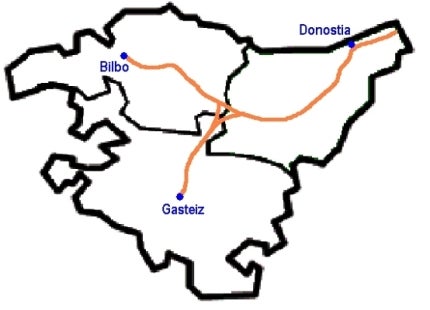
Basque Y (also known as Y Vasca) is a 172km-long high speed network currently under construction in Spain. Basque Y will connect the three capitals in the Basque Autonomous Region, Bilbao, Vitoria and San Sebastián, and will transport both goods and passengers.
The new rail network is one of the 14 infrastructure projects designated as priority by the European Union at the Essen Summit in December 1999 and will help the Basque Country to form a new railway link with Europe.
Construction on Basque Y was launched in October 2006 and is expected to be completed by 2017. ADIF, the Spanish state-owned company, is responsible for the construction.
Basque Y high-speed railway network project details
The proposal to develop a high-speed railway network in the Basque Country dates back to 1987 when the Spanish Railway Transport Authority built a new railway access to Andalusia. An investigation into the existing railway infrastructure revealed the necessity to upgrade the network to high-speed links.
The first step towards the project was the inauguration of a high speed railway link between Madrid and Seville in April 1992. A list of strategic projects for the continent was created, which included a high-speed network for the Basque Country.
Environmental Impact Assessment was conducted on the project in early 2000. Proposals were sent to the EU High Commissioner of Transport in November 2005 for their support for construction and infrastructure management of the project.
Ministry of Public works and Basque Department of Transport signed an agreement for the construction of Basque Y. Construction work followed with the launch of works on the Arrazua/Ubarrundia-Legutiano stretch. The latest technologies and innovative construction methods are being used in the construction.
Basque Y line routes
The project features two lines, Vitoria – Bilbao and Bergara – San Sebastián – Irun, which connect the cities of Bilbao, Donostia-San Sebastian, Irun, Astigarraga and Vitoria-Gasteiz. The lines are subdivided for construction based on the three provinces Bizkaia, Álava and Gipuzkoa that make up the Basque country.
The whole route includes 104.3km (60.64%) of tunnels, 17km (9.93%) of viaducts and 50.62km (29.43%) of open air network.
Related project
Bilbao Metro, Spain
A rapid transit railway underground network, the Bilbao Metro is owned and operated by Basque-based Biscay Transport Consortium (CTB). CTB uses a meter-gauge network for the Bilbao Metro. The network is completely underground.
Infrastructure and rolling stock for the Basque Y
The rolling stock for the Basque Y is being designed with advanced technology, while minimising the negative impact on the environment.
The whole stretch is designed to run on standard gauge so as to make it compatible with the European network. Passenger trains will run at speeds of up to 220kmph, while freight services will operate at speeds of up to 120kmph.
Benefits of a high-speed Basque Country rail network
The Y network will greatly reduce travel times between the capital cities. Statistics reveal that approximately 47,000 trips occur daily between the three metropolitan cities, with the Y network providing a great advantage and considerably easing the traffic.
The travel time between Bilbao and Vitoria-Gasteiz, Bilbao and Donostia-San Sebastian, and Vitoria-Gasteiz and Donostia-San Sebastian will be reduced by 32 minutes, 37 minutes, and 56 minutes respectively, when compared to road transport.
The new network will also provide links to important logistic areas of the country, such as Port of Bilbao, Port of Pasaia, and Jundiz. It will also help to connect to Spanish and European high-speed networks.
The project will also provide low energy transport and comfortable, quick and straight access to the capital cities in Basque provinces. The line, when finished, will ease congestion due to road traffic, reduce probability of accidents and help in territorial integration.
Financing for the Basque Y project
The project is being financed completely by Railway Infrastructure Authority of Spain. It faced long delays because of oppositions in funding during critical economic conditions. Ministry of Public Works and the Department of Transport finally signed the agreement for financing €4.1bn ($5.1bn) for the project, in April 2006.
In November 2007, European Commission for Transport made a direct investment of €118.5m ($175.5m) in the project. The European Investment Bank (EIB) agreed to provide a loan of €1bn ($1.27bn) for the project, of which €500m ($637m) was released in June 2012. The loan will be repaid over a period of 30 years with a grace period of 30 years.




